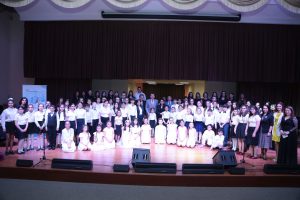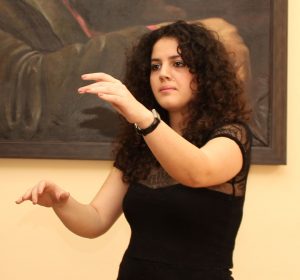The Choir: An Instrument of Social Inclusion in Azerbaijan
By Leyla Muradzade, conductor and singer
The emergence and development of the choral culture in Azerbaijan has undergone a long evolution process. Unlike in other European nations, this art is not indigenous to Azerbaijan. I would like to note that Uzeyir Hajibeyov, a great Azerbaijani composer, publicist and educator, who made an invaluable contribution to the development of professional Azerbaijani music in many ways, laid the foundations for choral art, thus creating another channel for absorbing European culture and enriching it with national traditions.
The history of this genre in Azerbaijan originates in 1908, when “Leyli and Majnun”, the first opera ever to be released in the Middle East, was composed by the Hajibeyov. The composer laid the foundations for the future achievements of the professional choral art in Azerbaijan by combining two traditions – Eastern monotonic and European polyphonia.


Returning to the present day, in early 2019 we launched the project entitled “Yüksəl, ey Azərbaycan” (Raise, Azerbaijan). First of all, we should note that it is a social initiative that was completed this May with the release of a choral album of 12 songs performed by around 250 children and teenagers. The aim of the project was to promote choral music among children and young people and to help them in developing and refining their collective singing skills. The choir is the perfect embodiment of the ideology of solidarity and equality. It should be noted that the involvement of children with physical disabilities in the project significantly contributed to increasing their activity and uncovering their musical potential. These young people trained to prepare for the performance with a great enthusiasm. All the students had various degrees of vision impairment and some of them were completely blind. In order to work on the project both individual and collective sessions were necessary. Choosing an appropriate repertoire and developing a sense of music and rhythm in the choir members was of great importance in this process. Although I had already had several years of experience working with the Children’s Chorus, for the first time ever I got to experience working with visually impaired children, many of whom had no musical education. Of course, I knew in advance that it would be difficult to create a choral ensemble, so I decided to work with each child individually on their voice first and organized vocal classes. Then I trained them in small groups of two or three. And lastly, as a soloist, I was able to assemble a chorus of 15 people and record the song “Odlar Yurdu” (“Country of Fire”). Prior to this process, I used rall call tactics to cut ties between small groups. That is, we practiced continuous reading in small groups of the same sentence. Azerbaijan is planning to do this with the Braille Alphabet. Music educators will begin to use the textbook by G.A. Smirnov, “Notes on the Braille System” (GA Smirnov, “The Post Office”). This textbook is designed to teach music to children with visual impairments.
Following this project, I plan to launch new initiatives to promote choral music, particularly among children and teenagers with no musical education. Since social responsibility is a very significant part of my vision, I hope to include vulnerable social groups who need special care and support.
 Leyla Muradzade was born in Baku on 30 April 1991. She graduated from musical secondary school in 2008 and in the same year she joined the Baku Musical Academy, named after Uzeir Hajibayli. She specialized in Choir Conducting. Leyla also got a Master degree in Conducting History and Theory in 2014 and then began her PhD in 2015 at the Azerbaijan National Conservatory. She was awarded the “Special Stipend of the President of Azerbaijan” as a “Special talented young person” and a member of the “Children’s Chapel Choir” in 2008 after successfully participating in the “Goodwill angels of Azerbaijan” concert at the UNESCO office in Paris. Her professional life started with the “Azerbaijan State Choir” in 2012 as a choral artist. At the same time she also began to work with the “State Children’s Philharmonic” as a choirmaster of the children’s choir. Email: mouradzadeah@gmail.com
Leyla Muradzade was born in Baku on 30 April 1991. She graduated from musical secondary school in 2008 and in the same year she joined the Baku Musical Academy, named after Uzeir Hajibayli. She specialized in Choir Conducting. Leyla also got a Master degree in Conducting History and Theory in 2014 and then began her PhD in 2015 at the Azerbaijan National Conservatory. She was awarded the “Special Stipend of the President of Azerbaijan” as a “Special talented young person” and a member of the “Children’s Chapel Choir” in 2008 after successfully participating in the “Goodwill angels of Azerbaijan” concert at the UNESCO office in Paris. Her professional life started with the “Azerbaijan State Choir” in 2012 as a choral artist. At the same time she also began to work with the “State Children’s Philharmonic” as a choirmaster of the children’s choir. Email: mouradzadeah@gmail.com
Edited by Mirella Dina Biagi, UK/Italy

